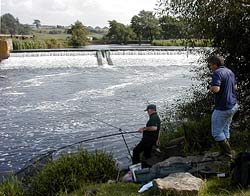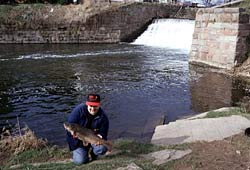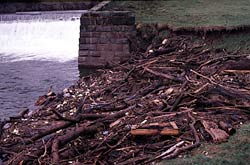I’ve fished lots of weirpools on different rivers and they have become firm favourites for providing excellent catches of a variety of good quality species, but especially for barbel. Many small weirpools are nice, peaceful places to fish, while the larger weirpools are quite daunting to many anglers when they see the white water powering over the sill, cascading onto the apron and then exploding into a foaming maelstrom. The old adage of not judging a book by its cover is very true however, for what goes on beneath the surface can be very different to what you see on it.
Weirpools are notorious for being snaggy, for the intricacies of the currents ensures that all manner of flotsam and jetsam is carried round in the eddies and backflows until it becomes waterlogged and sinks. As well as these snags being a disadvantage, in that they can be tackle devouring monsters, they can also be an advantage, for they are usually hot-spots, especially for barbel. Location of barbel certainly becomes easier, for it is a case of find the snags and you find the barbel. It pays to fish weirpools with at least slightly heavier tackle than you would normally use in that same river. Where 8lb line would be your norm for barbel fishing, then use 10lb in a weirpool, or even 12lb where the barbel grow big, especially if you intend fishing a snag swim. There are snags in a Dane weirpool I fish that most anglers tackle with 12lb line. Locating Barbel In The Weirpool Weirpools offer a great variety of swims. Even where the white water crashes onto the apron can be an excellent place to fish, for the apron is there to protect the bottom from being gouged out from that mad rush of water. Barbel, fish which are built to withstand strong currents, love to lie below the apron, sliding out to feed in the turbulence for a minute or two, before gliding back under to take a break. Below the apron is an undercut where the water is fairly calm and there will be one or more hot-spots along that apron where you will catch more barbel than any other. There may be a boulder that provides a food trap, or a slightly deeper hole that also holds more food than other areas. Most often the only way of finding these features is to fish, over a period of several weeks, or longer, each spot along the apron and see what transpires. The main rush of water down the centre of the ‘pool is the next place to try, in fact in certain conditions it should be the first place to cast a bait. This centre flow is usually the deepest spot, and later in the day, in summer, when the sun is high, it can be where the barbel move to following an early morning feed under the apron. The side eddies are best when the water is high and coloured following a spell of heavy rain. And for some reason I can’t fathom I’ve found the side eddies can be very productive in the evenings, regardless of conditions. Finally, as I said earlier, if there are snags in any of the swims then it is almost certain you will find barbel in and around them. It will probably take a couple of seasons before you have a detailed picture of a weirpool, before you are able to predict with any certainty where you will take barbel in a variety of conditions. Tackle for Weirpool Barbel I use a 12ft, purpose-built barbel rod for weirpool barbel fishing. It is supple enough in the tip to register tentative bites, but has the power to handle the biggest fish in the worst of snags. Most often my main line is 12lb test, with a hook length of 10lb. Hook is a strong size 6 for big baits like cubes of luncheon meat and lobworms, and a Drennan Super Specialist size 14 for small baits like maggot and caster. Occasionally I’ll drop down to a 16 when the barbel are being especially fussy, providing I’m fishing a swim where there are no snags. I fish boilies and pellets, and sometimes luncheon meat, on a hair rig.
Close-in swims can be tackled with a big stickfloat or Avon type float, but the shot must be bulked to get the bait through the fast surface water. Float fishing weirpool swims at long range, over 25yds say, can be difficult, for the line between rod and float is prone to going anywhere in that network of surface currents, and usually does go anywhere except the same way as the float. The bigger the float and the more shot you fish the easier it will be to keep the float under control, and it helps a hell of a lot if you treat the line with line grease to keep it on the surface. A sunken line when float fishing a weirpool is a complete waste of time. The bait will do everything except behave as you want it to. When fishing close to snags for barbel (with no less than 10lb line) you can’t afford to pussyfoot around. The bites are usually unmistakable, and you should sit with your hand on the rod and when the rod tip bangs over simply lift the rod to a vertical position and hang on. Don’t give an inch, other than what the bend in the rod will allow. The barbel will keep trying to dig deeper into the snag and more often than not you’ll end up with a stalemate, where the fish can’t dig any deeper, and you can’t reasonably pull any harder. Keep hanging on and with a little luck the barbel will give before you or the tackle do, and once you’ve removed it from the snag it is usually plain sailing from there to the net. Baits All the usual barbel baits: luncheon meat, sausage or Peperami sections, sausage meat paste, luncheon meat paste, boilies, lobworm, sweetcorn, maggot and caster, are all excellent most of the time. As a rule of thumb I use particle baits in a swimfeeder when the water is low and clear, big baits at night, and big, smelly baits when the water is coloured. One of my favourite baits for high and coloured water is the lob. Barbel love them most of the time, but especially when the water is brown, or turning brown. Take Care When Feeding Feeding the swim in a weirpool is probably the most difficult aspect to get right. Loose feeding is a real gamble for the surface flow can carry the bait away from where you want it to end up. Which means that loose feeding has the reverse effect, pulling fish away from the swim rather than into it.
Big, solid baits, such as cubes of luncheon meat, boilies, sections of sausage and Peperami, etc, can be fed with a stringer or PVA bag. Even the fastest dissolving PVA isn’t likely to be fast enough to melt before the bait hits bottom, and you can double or triple the string to prolong the melt time to make absolutely sure. On slow-flowing swims I often use a stringer or PVA bag, for other than a swimfeeder there are few better ways of ensuring the loose feed lies close to the hookbait. Give Them A Go If you’ve been put off weirpools in the past, because of the wild water in some of them, remember that most often it is a different world entirely closer to the bottom. Give them a try, you could be pleasantly surprised. |
Welcome!Log into your account













